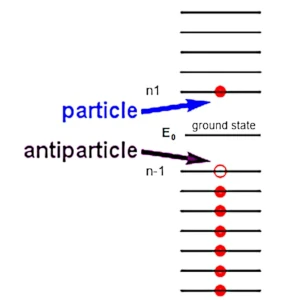
Antimatter was predicted by Paul Dirac (1902-1984) in 1928 from the relativistic equation of the electron. Each particle has an antiparticle of the same mass but opposite charge. The meeting of a particle with its antiparticle results in total annihilation and the conversion of mass into energy according to \( E = mc^2 \).
Each antiparticle has the same mass as its corresponding particle but can take on negative energy values within the framework of Dirac's theory. According to this theory, the space of quantum states is filled with negative energy levels, forming what is called the Dirac sea.
A vacant state in this Dirac sea behaves like an antiparticle of opposite charge. When this state is occupied or annihilated, the negative energy is released as radiation or converted into kinetic energy, allowing the observation of the creation or annihilation of particles and antiparticles.
Thus, the energy of antiparticles can be interpreted at two levels:
This energy duality is the basis of many physical phenomena: matter-antimatter annihilation, the production of antihydrogen in the laboratory, and quantum energy transitions that can release observable γ photons.
Antiparticles do not have negative mass. In Dirac's formalism, they can be seen as solutions with negative energy, but their rest mass is positive and identical to that of their corresponding particle.
When Paul Dirac (1902-1984) solved his relativistic equation for the electron, he found two families of solutions:
To prevent the electron from "falling" into increasingly lower energy states, Dirac proposed that all these negative levels were already filled: this is the Dirac sea. A "hole" in this sea behaves like a particle with the opposite charge: the positron.
In this interpretation, we indeed speak of negative energy, but the rest mass \(m\) remains positive (for example, \(m_e = 0.511~\mathrm{MeV}/c^2\)).
The rest mass of a particle is the coefficient before \(c^2\) in \( E^2 = p^2 c^2 + m^2 c^4 \). The sign of \(E\) (total energy) can change, but the term \(m^2\) always remains positive in the standard formalism. Even for antiparticles, we retain \(m >0\). What changes are the charges and quantum numbers (baryonic, leptonic, etc.).
A negative mass would mean that an object accelerates in the opposite direction to the applied force (exotic behavior). Nothing in the observations of antiparticles (positrons, antiprotons, etc.) shows such an effect: they fall in gravitational fields like their ordinary counterparts (within experimental limits).
| Particle | Antiparticle | Positive Energy Level | Negative Energy Level | Interpretation |
|---|---|---|---|---|
| Electron | Positron | +0.511 MeV | -0.511 MeV | Occupied state in the Dirac sea; a hole corresponds to a positron |
| Proton | Antiproton | +938.3 MeV | -938.3 MeV | Antiproton interpreted as a vacant state in negative energy |
| Neutron | Antineutron | +939.6 MeV | -939.6 MeV | Antineutron associated with a hole in negative levels |
| Neutrino | Antineutrino | ≈ 0 MeV | ≈ 0 MeV | Very low energy, almost indistinguishable antiparticle |
Sources: CERN – Antimatter, Particle Data Group, Wikipedia – Dirac Sea.